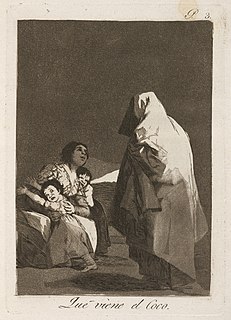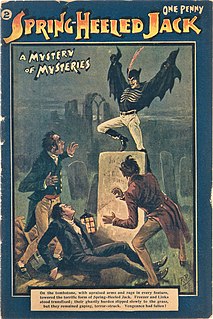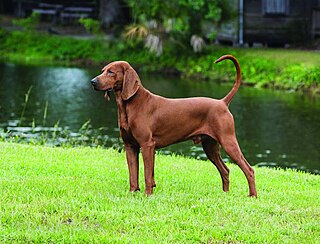
The Man in the Moon refers to any of several pareidolic images of a human face, head or body that certain traditions recognize in the disc of the full moon. The images are based on the appearance of the dark areas and the lighter-colored highlands of the lunar surface.

The Bogeyman is a type of mythic creature used by adults to frighten children into good behavior. Bogeymen have no specific appearance and conceptions vary drastically by household and culture, but they are most commonly depicted as masculine or androgynous monsters that punish children for misbehavior. The Bogeyman or conceptually similar monsters can be found in many cultures around the world. Bogeymen may target a specific act or general misbehaviour, depending on what purpose needs serving, often based on a warning from the child's authority figure. The term "Bogeyman" is sometimes used as a non-specific personification or metonym for terror, and in some cases, the Devil.

In English folklore, Black Shuck, Old Shuck, Old Shock or simply Shuck is the name given to a ghostly black dog which is said to roam the coastline and countryside of East Anglia, one of many such black dogs recorded in folklore across the British Isles. Accounts of Black Shuck form part of the folklore of Norfolk, Suffolk, the Cambridgeshire Fens and Essex, and descriptions of the creature's appearance and nature vary considerably; it is sometimes recorded as an omen of death, but, in other instances, is described as companionable.

The Poodle, called the Pudel in German and the Caniche in French, is a breed of water dog. The breed is divided into four varieties based on size, the Standard Poodle, Medium Poodle, Miniature Poodle and Toy Poodle, although the Medium Poodle variety is not universally recognised.
In Northern English folklore, the Barghest or Barguest is a mythical monstrous black dog with large teeth and claws, though in other cases the name can refer to a ghost or household elf, especially in Northumberland and Durham, such as the Cauld Lad of Hylton.

The Irish Terrier is a dog breed from Ireland, one of many breeds of terrier. The Irish Terrier is considered one of the oldest terrier breeds. The Dublin dog show in 1873 was the first to provide a separate class for Irish Terriers. By the 1880s, Irish Terriers were the fourth most popular breed in Ireland and Britain.

Spring-heeled Jack is an entity in English folklore of the Victorian era. The first claimed sighting of Spring-heeled Jack was in 1837. Later sightings were reported all over the United Kingdom and were especially prevalent in suburban London, the Midlands and Scotland.

A hellhound is a mythological hound which embodies a guardian or a servant of hell, the devil, or the underworld. Hellhounds occur in mythologies around the world, with the best known examples being Cerberus from Greek mythology, Garmr from Norse mythology, the black dogs of English folklore, and the fairy hounds of Celtic mythology. Physical characteristics vary, but they are commonly black, anomalously overgrown, supernaturally strong, and often have red eyes or accompanied by flames.

The Redbone Coonhound is an American breed of hunting dog. It may be used to hunt raccoon, deer, bear, boar, cougar, or other large game. It originated in the Southern United States, and derives from foxhounds brought by immigrants from Scotland. It is characterized by its deep red coat.
The cadejo is a supernatural character from Central American folklore. There is a good white cadejo and an evil black cadejo. Both are spirits that appear at night to travelers: the white to protect them from harm during their journey, the black to kill them. The sight of the cadejos are sometimes exchanged according to local tradition. In some places, the black cadejo is seen as the good one and the white cadejo the evil one. They usually appear in the form of a large, shaggy dog with burning red eyes and a goat's hooves, although in some areas they have more bull-like characteristics. According to the stories, many have tried to kill the black cadejo but have failed and perished. It is also said that if a cadejo is killed, it will smell terrible for several days, and then its body will disappear. Some Guatemalan and Salvadoran folklore also tells of a cadejo that protects drunks against anyone who tries to rob or hurt them. When the cadejo is near, it is said to bring about a strong goat-like smell. Most people say never to turn your back to the creature because otherwise you will go crazy. Speaking to the cadejo will also induce insanity.
The gwyllgi is a mythical dog from Wales that appears as a frightful apparition of a mastiff or Black Wolf with baleful breath and blazing red eyes. It is the Welsh incarnation of the black dog figure of English folklore.
Brazilian mythology is the subset of Brazilian folklore with cultural elements of diverse origin found in Brazil, comprising folk tales, traditions, characters and beliefs regarding places, peoples, and entities. The category was originally restricted to indigenous elements, but has been extended to include:

Outlaws is a video game for the Commodore 64 developed and released by Ultimate Play the Game in 1985. In a break from earlier arcade adventure titles such as The Staff of Karnath and Entombed, Outlaws is a straightforward shooter game and does not feature the aristocrat adventurer Sir Arthur Pendragon.

The black dog is a supernatural, spectral or demonic entity originating from English folklore that has also been seen throughout Europe and the Americas. It is usually unnaturally large with glowing red or yellow eyes, is often connected with the Devil, and is sometimes an omen of death. It is sometimes associated with electrical storms, and also with crossroads, barrows, places of execution and ancient pathways.
Mythic humanoids are mythological creatures that are part human, or that resemble humans through appearance or character.

The Sack Man is a figure similar to the bogeyman, portrayed as a man with a sack on his back who carries naughty children away. Variants of this figure appear all over the world, particularly in Latin countries, such as Spain, Portugal, Italy (where he is known as the vecchio col sacco, and the countries of Latin America, where it is referred to as el "Hombre del costal", el hombre del saco, or in Portuguese, o homem do saco, and Eastern Europe. Similar legends are found in Haiti and some countries in Asia.

Cave Hole is a large cave on the south east side of the Isle of Portland, a large peninsular in Dorset, England. It has a blowhole and a wooden crane, known as Broad Ope Crane on the cliff top. It is 1⁄2 mile (800 m) north-east of Portland Bill, has an interior measuring 50 feet (15 m) square and 21 feet (6.4 m) high.











